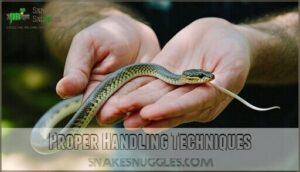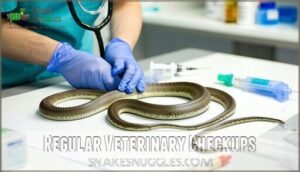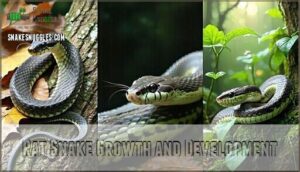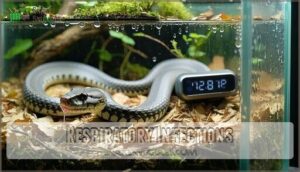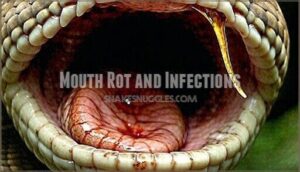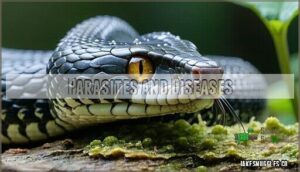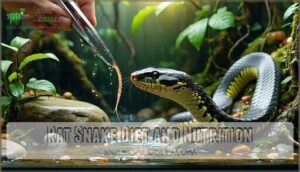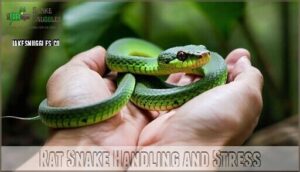This site is supported by our readers. We may earn a commission, at no cost to you, if you purchase through links.

You’ll need to maintain consistent temperatures between 75-85°F, provide appropriate humidity levels, and establish a regular feeding schedule with appropriately-sized prey items.
Regular health monitoring helps catch issues like respiratory infections or parasites early.
The key factors that’ll determine your snake’s longevity include genetics, diet quality, enclosure conditions, and stress management. Understanding the specific needs during each life stage becomes essential for maximizing their potential.
Table Of Contents
- Key Takeaways
- Rat Snake Lifespan Factors
- Average Rat Snake Lifespan
- Rat Snake Care and Longevity
- Factors Affecting Rat Snake Lifespan
- Rat Snake Growth and Development
- Common Health Issues in Captivity
- Rat Snake Enclosure and Lifespan
- Rat Snake Diet and Nutrition
- Rat Snake Handling and Stress
- Maximizing Rat Snake Lifespan
- Frequently Asked Questions (FAQs)
- How long do rat snakes live as pets?
- What snake has the shortest lifespan in captivity?
- How old is a 5 foot long rat snake?
- Can different rat snake species interbreed successfully?
- Do rat snakes require winter brumation periods?
- What vaccinations do pet rat snakes need?
- How do you determine a rat snakes age?
- Are there legal restrictions on rat snake ownership?
- Conclusion
Key Takeaways
- You’ll get 15-20 years with your rat snake through proper temperature control (75-85°F), consistent feeding schedules, and regular health monitoring
- Your snake’s genetics set the baseline lifespan, but your husbandry practices determine whether it reaches maximum potential or falls short at 10 years
- You’ll prevent the most common killers—respiratory infections, mouth rot, and parasites—through proper humidity levels (40-60%) and clean enclosure maintenance
- You can maximize longevity by providing environmental enrichment, minimizing stress through gentle handling, and scheduling annual veterinary checkups for early disease detection
Rat Snake Lifespan Factors
Your rat snake’s lifespan in captivity depends heavily on three critical factors that work together to determine whether they’ll live closer to 10 years or reach their full potential of 25-30 years.
Getting these fundamentals right from day one makes the difference between a snake that merely survives and one that thrives for decades.
Diet and Nutrition
Your rat snake’s longevity hinges on proper nutrition. Feed frozen-thawed rodents sized to your snake’s body width—this meets their nutrient requirements perfectly.
Adults need feeding every 10-14 days, while juveniles require meals every 5-7 days.
Quality food sources support digestive health naturally. Avoid dietary supplements unless recommended by an exotic veterinarian.
Consistent rat snake diet schedules prevent obesity and malnutrition.
Enclosure Environment
Your snake’s enclosure environment directly impacts its longevity through proper temperature control and humidity levels.
Creating the right vivarium setup requires attention to substrate options, ventilation systems, and maintaining an appropriate temperature gradient.
Here’s what your rat snake needs for ideal enclosure conditions:
- Temperature gradient – Maintain 85-90°F basking area with 70-75°F cool zone
- Humidity control – Keep levels between 40-60%, increasing during shedding periods
- Enclosure size – Provide tank length matching snake’s body length minimum
- Substrate options – Use aspen shavings, cypress mulch, or hemp bedding for comfort
Health and Wellness
Throughout your captive rat snake’s journey, maintaining ideal health requires consistent disease prevention and wellness strategies.
Regular veterinary checkups help catch common snake health issues early, from respiratory infections to mouth rot.
You’ll want to monitor your pet’s physical conditioning through proper nutrition advice and environmental management.
Mental health matters too—stressed reptiles face shorter lifespans than content ones.
Smart reptile care combining preventive medicine with attentive observation dramatically extends rat snake lifespan, sometimes reaching that coveted 20-year mark.
This approach emphasizes the importance of consistent disease prevention in ensuring the long-term health of your pet.
Average Rat Snake Lifespan
When you’re considering a rat snake as a companion, understanding their snake life expectancy becomes your first priority.
Most captive rat snakes live between 10-30 years, with proper care typically extending their captive lifespan to 15-25 years.
That’s a significant commitment compared to many other pets.
Your snake’s longevity depends heavily on species variation.
Corn snakes often reach 15-20 years, while black rat snakes can live up to 30 years with exceptional care.
These numbers represent snake aging under ideal conditions – think of it as your pet’s potential rather than a guarantee.
Wild rat snake mortality rates are much higher due to predators, disease, and environmental stressors.
In your controlled rat snake habitat, you’re eliminating these natural threats.
This protection dramatically improves rat snake longevity compared to their wild counterparts, who typically survive only 1-15 years.
Understanding these baseline expectations helps you prepare for the long-term responsibility.
Your snake care tips and dedication will determine whether your pet reaches the lower or upper end of this range.
Rat Snake Care and Longevity
You’ll extend your rat snake‘s lifespan substantially through consistent care practices that address their specific needs.
The care practices include proper handling, environmental enrichment, and regular veterinary check up which form the foundation of longevity in captive rat snakes.
Proper Handling Techniques
Handle your rat snake gently but confidently to build trust over time.
Support their body weight properly during safe restraint, never grabbing just the head or tail.
Most rat snakes have docile temperament, making snake handling tips straightforward.
Watch for stress signals like rapid breathing or defensive posturing to recognize temperament changes.
Limit handling frequency to 2-3 times weekly, avoiding bites through calm movements.
Children handling requires adult supervision always.
Environmental Enrichment
Environmental enrichment transforms a basic snake enclosure into a stimulating habitat that promotes natural behaviors and extends captivity lifespan.
Strategic placement of climbing structures encourages exercise, while multiple hiding spots reduce stress levels.
Novel objects rotated monthly prevent boredom and support psychological wellbeing in your snake enclosure.
- Climbing branches and ledges – Give your rat snake the chance to explore vertically, just like they’d in trees
- Multiple hiding spots – Create safe havens where your snake can retreat and feel secure
- Textured surfaces and digging opportunities – Let them experience different textures that stimulate natural foraging behaviors
Regular Veterinary Checkups
Schedule annual checkups with a reptile veterinarian for preventative care and early detection of health issues.
These visits include parasite screening, physical exams, and expert advice on husbandry improvements.
Regular health monitoring catches common health issues like respiratory infections and mouth rot before they become serious.
Professional snake health assessments substantially impact snake lifespan factors through proactive medical intervention.
Good sanitation and proper environment design can prevent reptile health issues, which is crucial for reptile health.
Factors Affecting Rat Snake Lifespan
Several key factors determine how long your rat snake will live in captivity.
Your snake’s genetics, species type, and overall health management directly impact whether it reaches the lower or upper end of its 15-30 year lifespan potential.
Genetics and Breed
Your rat snake’s genetic makeup directly impacts its potential lifespan, with some lineages living longer than others.
Snake genetics play a bigger role than you might think in determining longevity.
- Morph Variations – Designer morphs like Albino and Snow often have shorter lifespans due to genetic mutations
- Selective Breeding – Selectively bred snakes may inherit health issues from concentrated gene pools
- Genetic Health – Wild-type genetics typically offer better disease resistance and longevity
- Hybridization – Cross-species breeding can create vigor but also unpredictable health outcomes
- Lineage Tracing – Knowing your snake’s family history helps predict potential genetic conditions
Size and Age
Your captive rat snakes reach adult size between 3-8 feet, depending on species.
Growth rate slows substantially after sexual maturity at 18-24 months.
Size variations affect lifespan—larger specimens like Black rat snakes often live longer than smaller varieties.
Weight ranges from 4-8 pounds impact feeding schedules.
Snake lifespan in captivity correlates with proper growth management and size-appropriate care throughout their development phases.
Health Conditions and Diseases
Disease threats can dramatically cut your snake’s lifespan from 15-20 years to just 8-10 years.
Mouth rot affects 10-15% of captive reptile populations, while respiratory issues strike up to 20% when humidity isn’t controlled properly.
Parasite prevention through regular fecal screening reduces infections by 60%, and scale rot, as well as anorexia causes, require immediate veterinarian attention to prevent fatal complications.
Rat Snake Growth and Development
Your rat snake’s growth follows three distinct developmental phases that directly impact their care requirements and overall lifespan.
Understanding these stages helps you provide age-appropriate housing, feeding schedules, and environmental conditions that support healthy development throughout their 15-20 year captive lifespan, which is a key factor in their overall well-being and healthy development.
Juvenile Stage
Your young rat snake enters the world as a vulnerable hatchling measuring just 8-12 inches.
Hatchling care requires precise attention during these critical first months.
Initial feeding starts with pinkie mice every 5-7 days, supporting their rapid growth rate.
You’ll notice shedding frequency increases dramatically—juveniles shed every 3-4 weeks compared to adults’ quarterly schedule.
Their enclosure size should accommodate this swift development, as snake lifespan depends heavily on proper juvenile management and snake feeding consistency.
Sub-Adult Stage
Between 6 months and 2 years, your rat snake enters adolescence with noticeable changes.
Growth spurts require careful monitoring as their bodies rapidly develop.
This period brings several important considerations:
- Feeding changes – Increase prey size gradually as your snake outgrows smaller mice
- Enclosure upgrades – Expand housing to accommodate their growing length and climbing needs
- Temperament shifts – Expect some moodiness during hormonal development phases
- Shedding frequency – Sub-adults shed more often than adults, requiring higher humidity levels
Maintaining proper temperatures is key, so always monitor enclosure temperature gradients.
Adult Stage
Reaching maturity around three years, your adult rat snake enters its prime phase in captivity.
Adult feeding shifts to larger prey items every 10-14 days, supporting their 4-8 foot size variation.
Breeding behavior emerges, while adult shedding occurs less frequently, and temperament changes often include increased docility.
Rat snakes may exhibit aggressive defensive behaviors if they feel threatened.
Proper snake diet and snake health monitoring maximize their 15-25 year lifespan potential.
Common Health Issues in Captivity
While rat snakes are hardy reptiles, you’ll encounter several health challenges that can substantially impact their 15-20 year captive lifespan if left untreated.
Understanding these common ailments—respiratory infections, mouth rot, and parasites—helps you maintain your snake’s health through early detection and proper veterinary care, which is crucial for addressing issues like mouth rot.
Respiratory Infections
Respiratory infections rank among snake common health problems, affecting 20-30% of new rat snakes during acclimation.
Causes include poor ventilation, temperature below 70°F, and high humidity above 80%.
Symptoms manifest as open-mouth breathing, nasal discharge, and wheezing in 80% of cases.
Treatment involves antibiotics with 85% recovery rates when administered promptly.
Prevention requires maintaining proper temperature gradients and humidity levels.
Early prognosis improves dramatically with quick intervention, directly impacting snake lifespan expectations in captivity.
Mouth Rot and Infections
Infectious stomatitis, commonly called mouth rot, affects many captive rat snakes when bacteria invade oral tissues.
You’ll notice telltale signs like swollen gums, yellowish discharge, or difficulty eating.
This condition requires immediate veterinary attention since it can quickly worsen without proper treatment.
A key indicator is redness or swelling in the mouth, signaling inflammation.
Key prevention and treatment steps:
- Maintain proper humidity levels (40-60%) to prevent dry mouth conditions that encourage bacterial growth
- Sanitize water bowls weekly and replace substrate regularly to minimize harmful bacteria in the enclosure
- Seek veterinary care immediately if you spot mouth rot symptoms – antibiotics and antiseptic rinses typically resolve infections effectively
Parasites and Diseases
Several parasites and diseases threaten your rat snake’s health beyond respiratory issues and mouth rot.
Internal parasites like mites and ticks can weaken your snake’s immune system.
Fungal infections often develop in overly humid conditions.
Blister disease appears as fluid-filled bumps on the belly.
Parasite prevention requires regular veterinary checkups and proper enclosure hygiene.
Contact a reptile veterinarian immediately if you notice unusual behavior or physical changes in your snake, as immediate action can be crucial.
Rat Snake Enclosure and Lifespan
Your rat snake’s enclosure directly impacts its 15-20 year lifespan potential through proper space, temperature control, and environmental conditions.
Creating the right habitat guarantees your snake thrives for decades rather than merely surviving, ensuring it reaches its full potential.
Space and Ventilation
Providing adequate space transforms your rat snake’s quality of life and extends their lifespan in captivity. Your enclosure size should match your snake’s length, with secure lids preventing escapes that could prove fatal.
Proper airflow design prevents respiratory infections through strategic ventilation methods. Climbing space mimics natural habitats, reducing stress. Well-ventilated tank sizes promote healthy air circulation, directly impacting longevity.
Insufficient airflow can be mitigated with specialized tank equipment, ensuring a healthy environment for your rat snake, which is crucial for their overall well-being.
Temperature and Humidity
Maintaining proper basking temperature (85-90°F) and nighttime drop to 70-75°F creates the thermal gradient essential for your snake’s lifespan in captivity.
Humidity levels should stay between 40-60%, increasing to 60-70% during shedding periods.
Digital monitoring tools help track these conditions precisely, and consistent temperature and humidity control prevents respiratory infections and supports healthy shed cycles.
This control directly impacts your rat snake’s longevity and overall snake care success.
Lighting and Accessories
Lighting setup doesn’t require UVB lighting like other reptiles, but you’ll need heat sources.
Choose between heat lamps, ceramic heat emitters, or heat mats to create your temperature gradient.
Add basking bulbs for daytime warmth.
Complete the setup with hiding decor, water bowls large enough for soaking, climbing branches for enrichment, and appropriate substrate types.
Rat Snake Diet and Nutrition
Proper nutrition forms the foundation of your rat snake’s long-term health and directly impacts their 15-20 year lifespan potential.
You’ll need to establish a consistent feeding schedule with appropriately sized prey items to support ideal growth and maintain their robust immune system throughout their adult years, ensuring a long-term health foundation.
Feeding Frequency and Schedule
Your rat snake’s feeding schedule directly impacts its lifespan and health.
Juveniles need frozen-thawed mice every 5-7 days for proper growth, while adults thrive on weekly feedings.
Overfeeding risks obesity and shortened lifespans, and seasonal changes may naturally reduce appetite during winter months.
Consistent feeding frequency prevents stress and maintains ideal body condition throughout your snake’s life.
Owners often buy pre-killed rodents for convenience.
Prey Items and Sizes
Proper rodent size prevents feeding injuries and regurgitation episodes. Match prey width to your snake’s thickest body section—never exceed 1.5 times this measurement.
Frozen-thawed mice offer safer feeding than live prey options.
- Hatchlings: Pinky mice under 3 grams work best
- Sub-adults: Graduate to fuzzies and small adult mice (7-10 grams)
- Adults: Adult mice or small rats between 15-25 grams
Supplementation and Vitamins
Unlike most pets, rat snakes don’t need vitamin supplements when fed whole prey items.
Frozen-thawed mice and rats contain complete nutrition, including adequate calcium intake and Vitamin D3 levels.
Adding multivitamin benefits isn’t necessary for healthy pet rat snakes following proper captive snake care protocols.
Mineral balance occurs naturally through diet, making supplement schedules unnecessary for most feeding situations.
However, calcium with added D3 may be needed if deficiencies are suspected.
Rat Snake Handling and Stress
Proper handling and stress management directly impact your rat snake’s lifespan, with chronic stress weakening their immune system and shortening their life.
You’ll need to master gentle handling techniques and recognize early stress signals to guarantee your snake thrives for the full 15-20 years in captivity, ensuring they live a long and healthy life with proper handling.
Handling Techniques and Tips
Supporting proper nutrition, you’ll want to master safe handling techniques to keep your rat snake calm and healthy.
Always approach slowly and support the snake’s body with both hands – never grab just the head or tail.
Wait 48 hours after feeding before handling to prevent regurgitation. Handle juveniles briefly and less frequently than adults.
For added safety, consider using specialized handling equipment. Watch for defensive posturing like coiling or hissing, which signals you should back off and try later, using proper handling to ensure safety.
Stress Reduction and Minimization
Minimizing stress keeps your rat snake healthier and extends their lifespan substantially.
Creating the right environment makes all the difference in their well-being.
Here are three essential stress reduction strategies:
- Provide multiple secure hides throughout the enclosure to reduce stress response by over 60%
- Limit handling sessions to prevent overstimulation and allow natural behaviors to flourish
- Maintain quiet environment with consistent temperatures and minimal external disturbances
Enrichment activities like climbing branches promote natural behaviors while proper enclosure design with visual barriers prevents defensive posturing.
Recognition of Stress Signs
Watch for hissing frequency increases and erratic movements as primary stress indicators.
Food refusal often signals deeper issues requiring immediate attention.
Defensive postures like coiling tightly or striking motions indicate your snake feels threatened.
Scale changes, particularly dullness or retained shed pieces, suggest environmental problems.
Lethargic snakes displaying anorexia need veterinary evaluation to rule out illness versus stress-related behavioral changes.
Maximizing Rat Snake Lifespan
Maximizing your rat snake’s lifespan requires consistent daily care and attention to environmental details.
You’ll need to maintain proper husbandry practices, monitor your snake’s behavior regularly, and create an enriching habitat that promotes natural behaviors.
Regular Maintenance and Cleaning
How often should you tackle enclosure maintenance to keep your rat snake thriving? Consistent cleaning prevents harmful microorganisms from compromising your snake’s health and extending its lifespan.
- Substrate Cleaning – Replace soiled substrate immediately when waste appears
- Water Changes – Refresh water bowl weekly or when contaminated
- Enclosure Disinfection – Deep clean monthly with reptile-safe disinfectant
- Waste Removal – Spot-clean feces and urates within 24 hours
- Accessory Sanitization – Clean hides and décor during monthly maintenance
Monitoring and Observation
Your snake’s daily routine tells a story about its health.
Regular snake health monitoring reveals subtle changes that predict problems before they become serious.
| Observation Area | What to Monitor |
|---|---|
| Behavioral Changes | Hiding patterns, exploration habits |
| Feeding Response | Appetite, strike accuracy |
| Activity Levels | Movement frequency, alertness |
| Shedding Patterns | Timing, completeness |
| Physical Examination | Body condition, weight monitoring |
Track these observations weekly.
Note unusual snake behavior observations in a simple log.
The snake shedding process should happen predictably every few months.
Changes in snake diet acceptance often signal stress or illness developing.
Providing a Stimulating Environment
Environmental enrichment transforms your rat snake’s captivity experience, directly extending their lifespan range through enhanced cognitive stimulation.
Research shows enriched snakes demonstrate improved learning abilities and reduced stress behaviors. Black ratsnakes benefit from UVB lighting for superior health.
Essential snake enrichment elements include:
- Climbing Branches – Vertical structures that encourage natural arboreal behaviors
- Hiding Spots – Multiple shelters creating security and comfort zones
- Varied Substrates – Different textures promoting natural burrowing instincts
- Enrichment Items – Rotating objects providing ongoing sensory stimulation
This approach supports ideal snake behavior and maximizes longevity.
Frequently Asked Questions (FAQs)
How long do rat snakes live as pets?
Time flies when you’re caring for these slithery companions! You’ll enjoy your rat snake’s company for 15-25 years in captivity with proper husbandry, consistent feeding schedules, and appropriate environmental conditions.
What snake has the shortest lifespan in captivity?
Small snake species like ringneck snakes, sand boas, and western hognose snakes typically have the shortest captive lifespans, living just 6-10 years.
Compared to larger species that can reach 20-30 years, this is a significant difference in lifespan.
How old is a 5 foot long rat snake?
Like reading growth rings on a tree, determining a rat snake’s age from its length isn’t straightforward.
You can’t pinpoint exact age since growth rates vary based on feeding, genetics, and environment, but most reach five feet around 3-5 years old, which can be considered a key milestone in their development, with growth being a crucial factor.
Can different rat snake species interbreed successfully?
Yes, different rat snake species can interbreed successfully in captivity.
You’ll find that closely related species like corn snakes and gray rat snakes produce viable offspring called intergrades, though this practice remains controversial among breeders, involving intergrades.
Do rat snakes require winter brumation periods?
Rat snakes don’t require winter brumation in captivity, unlike their wild counterparts.
You can maintain consistent temperatures year-round, though some keepers simulate cooler periods to encourage breeding behavior in their snakes.
What vaccinations do pet rat snakes need?
Unlike their wild cousins who face countless dangers, your captive rat snake doesn’t need any vaccinations.
Reptiles don’t receive routine immunizations like mammals do, so you’ll skip the vet visits for shots entirely.
How do you determine a rat snakes age?
Determining a rat snake’s age requires examining multiple physical indicators since there’s no foolproof method.
You’ll need to assess size, weight, scale condition, and overall body proportions, though individual genetics and care history substantially influence these markers.
Are there legal restrictions on rat snake ownership?
Like traversing a maze of regulations, owning a rat snake depends on your state’s rules and whether you’re keeping native species.
Most states require permits for native wildlife species, which aren’t typically issued for pets, while captive-bred non-native species generally face fewer restrictions than their wild counterparts.
Conclusion
Success with your rat snake’s lifespan in captivity ultimately depends on your commitment to consistent care protocols.
You’ll achieve the full 15-20 year potential through proper temperature regulation, appropriate feeding schedules, and proactive health monitoring.
Environmental stability, stress reduction, and regular veterinary checkups form the foundation of longevity.
Your snake’s genetics set the baseline, but your husbandry practices determine whether it reaches maximum lifespan potential in your care.
- https://pdfs.semanticscholar.org/a479/1ccadeacee91b8ede173b4f08d9ddb618444.pdf
- https://www.sciencedirect.com/science/article/pii/S0016648016303641?via%3Dihub
- https://www.cdc.gov/mmwr/preview/mmwrhtml/mm4844a1.htm
- https://www.merckvetmanual.com/all-other-pets/reptiles/routine-health-care-of-reptiles
- https://www.vettimes.com/clinical/exotics/health-screening-of-reptiles-cpdreptiles


